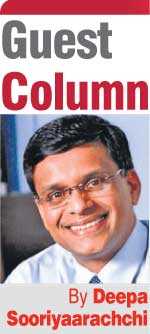Thursday Jan 02, 2025
Thursday Jan 02, 2025
Monday, 8 June 2020 00:15 - - {{hitsCtrl.values.hits}}

Leverage the experiences of the recent medicine distribution through post offices and build a centralised platform that can be used by private as well as public pharmacies to distribute medicine and dispense them to patients. Doctors should send the prescription to the preferred pharmacy of the customer. They can either collect or get them delivered. This will improve the regulated medicine consumption
The current crisis compels us to review all our operations from a ground zero position without taking knee jerk reactions. Experts who have examined many organisations that have survived major crisis whether they are internal or external driven, tell us one of the most important things is to consider what is the core purpose of the organisation, what are the core capabilities of the organisations and what are the strategic steps that must be taken leveraging them. In that situation what is equally important is asking the question whether the same strengths will be relevant in the emerging new scenario.
In our economy the public sector plays a significant role. With 1.5 million public servants, more than 6,000,000 pensioners and all the politicians accounts for at least 40% of the national expenditure.
There had been a number of efforts to rationalise, and improve the public sector with various initiatives. I myself was once volunteered to serve on one such initiative called the National Administrative Reforms Commission (NARC). But they were not done at times when the need is so compelling. In management we talk of showing the elephant in the room to make change relevant.
The present situation is an ideal moment to approach to rationalise, right size, and improve the productivity of the public sector organisations because of a number of reasons.
The current financial situation in the country is one of the worst we have been in so the need to rationalise expenses is seen as one of the topmost tasks.
The last two months gave us ample opportunities to try newer ways of working and service delivery and people have experienced the efficiency and effectiveness of those so we will be able to sell the change.
There is a leadership that is visionary and willing to move the change agenda forward.
In order to develop a discussion and to move towards a national action plan the writer wishes to make a few proposals that can have far-reaching consequences. These are written not as an expert on public policy and administration but as a concerned citizen with some knowledge and experience in management.
1. Centralise vehicle ownership
Most service organisations even in the public sector employee cost and transportation related costs account for a high proportion of the overall cost. One can assume same with the government agencies. I was trying to find out the latest statistics pertaining to the number of vehicles and associated costs but was not possible. But having led a government agency for a short period of three years I have made the following observations.
Most government vehicles are over used and due to lack of cash flow reasons they are not maintained at optimum levels.
Due to the very laborious process involved with selling off an old vehicle in many organisations there are vehicles just left to decay. There many such yards.
The vehicle usage is not optimum. Every organisation will have a number of vehicles.
There is a lot of management time spent to ensure the governance processes involved with using of these vehicles yet misuses are very common.
Every institution is duty bound to maintain detailed running charts and these have to be sent to the AGs department for scrutiny.
Rather than allowing every single organisation to own vehicles re acquire all the non-strategic vehicles to a central transport service corporation that can be operated as a fully-fledged cab company using a ICT platform such as Uber or PickMe. Pre-authorise the type of vehicle that can be used by different grades of officers and encourage ride shares by giving bonus points. This will cut down waste, improve efficiency and be able to provide better quality vehicles for the officers to travel as well. Because this institution’s core responsibility is vehicle fleet management it will ensure proper maintenance and upkeep of vehicles. This kind of an arrangement will provide valuable data to manage vehicle usage and resource planning.
I am sure this is not a new suggestion.
2. Mergers and acquisitions
In order to optimise the scarce resources suggest organisations that have similar mandates and those can produce better results through synergy be merged in to single entities. To do this meaningfully a high powered cross functional team must be appointed with Legal, Financial, ICT, Human Resources, and Public Administration experience and expertise. More importantly those individuals must be those capable of thinking out of the box.
E.g. all trading organisations such as state trading corporation, etc. can be brought under SATOSA.
The businesses that are better done by the private sector the government can exit i.e. Salusala and Laksala, etc.
All research institutes must be brought under a central authority to ensure proper coordination where resource allocation must be done based on the short to medium term needs of the country. This can avoid duplication of limited resources. There can be many other departments and agencies that do overlapping functions while there are no organisations to address newer issues. mThese are made more complex of the Provincial Council structure and the plethora of ministries created to accommodate politicians to ensure power consolidation in the parliament.
These structural changes will require changes in to respective acts and comprehensive M&A work.
Before embarking on detailed work a preliminary study should be done to reveal the financial and social impact. However the starting points could be restructuring commercial organisations.
3. Create centralised support services
Centralise all the support services such as Human Resources, Administrative, Procurement and Finance functions of those clustered entities so they can focus on core delivery function. This model should be tried at least for different institutions under a single ministry.
4. Work From Home (WFH) and provide end to end service online
Identify functions that can be done remotely in as many organisations as possible and create infrastructure, and work norms for the state employees to work from home, take files home, complete and deliver on given deadlines. They will have to be monitored not by the number of hours they work but by the delivery of outputs. This will ease off the pressure on transport, operational costs of offices and the personal costs of employees. Some institutions can work for less than five days a week without affecting delivery to public. Encourage public also to visit the government offices by making prior appointments.
There can be some other organisations whose work can be done significantly online i.e. obtaining ISBN numbers by authors and facilitate online payments and credit card payments.
5. Strengthen the Grama Sevaka office
Strengthen the GS office by converting it to the GS division based government contact centre by attaching at least one of the newly recruited graduates. His/her job should be act as a facilitator between the citizen and different government institutions. He or she should, read and explain all the requirements to citizens, certify and upload applications and supporting documents, give clear instructions as to how to approach requirements needed by the government. This should ease the work of service providers, reduce repetitive visits by the citizen. The GS office should be equipped with internet connections, video conferencing facility and high speed or at least flatbed scanning facility.
6. Strengthen the Postal Department as the last leg delivery partner for e commerce
Allow the post offices to hire three-wheelers so the postman’s delivery area can be increased and what can be carried too will be enhanced. This way they can specialise in delivering pensions and such needs of elderly, thus creating a very powerful user-friendly customer service. Eventually the profits can lead the postman to use their own three-wheelers. POST is the largest distribution network in the country. It might make sense for the Postal Department to be converted to a commercial establishment fully-owned or as a joint venture with a logistics company so Sri Lanka Post can be a fully-fledged modern distribution network. If not the department will continue to be a major cost centre without even being able to pay salaries of the employees.
7. Distribution of pharmaceutical items
Leverage the experiences of the recent medicine distribution through post offices and build a centralised platform that can be used by private as well as public pharmacies to distribute medicine and dispense them to patients. Doctors should send the prescription to the preferred pharmacy of the customer. They can either collect or get them delivered. This will improve the regulated medicine consumption. There may be some legislative changes needed to make these possible.
8. A platform to book government spaces
Create a platform such as booking.com where every single meeting room is listed, so they can be used and shared by different government users and if available even by private sector organisations. This will generate new income to those institutions.
These are just a few simple ideas that can propel changes in the system if implemented.
(The writer is a Management Consultant, Author, Speaker and Executive Coach. Former Managing Director of AVIVA NDB Insurance and a Former Commissioner of Sri Lanka Inventors Commission. He can be reached by [email protected] and [email protected].)